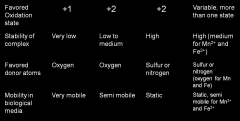![]()
![]()
![]()
Use LEFT and RIGHT arrow keys to navigate between flashcards;
Use UP and DOWN arrow keys to flip the card;
H to show hint;
A reads text to speech;
19 Cards in this Set
- Front
- Back
- 3rd side (hint)
|
Minerals are classified into 2 groups:
|
macro minerals
trace minerals: |
|
|
|
macro minerals
|
calcium
phosphorus sulfur magnesium |
|
|
|
calcium
phosphorus sulfur magnesium what class = |
macro minerals
|
|
|
|
trace minerals:
|
iron
zinc selenium copper fluorine iodine chromium |
|
|
|
iron
zinc selenium copper fluorine iodine chromium |
trace minerals:
|
|
|

|
.
|
|
|
|
Inorganic Enzyme Cofactors
(one-third of all enzymes require a metal ion for catalytic function) |

|
|
|
|
Examples of Metalloproteins
|
1. Metallothionein =
2. Ferritin 3. Calmodulin 4. Transferrin 5. Selenoprotein W = 6. Calbindin = |
Cu, Zn, Cd storage, heavy metal buffer
5 Selenium transport 6 Calcium transport |
|
|
Sodium
activation of ___: e.g., _______. ion gradient: muscle contraction, nerve conduction osmolality: osmotic pressure that controls water movement |
enzymes
chymotrypsin |
|
|
|
Clinical correlations:
hyponatremia = |
- A decreased sodium concentration in the blood.
- often caused by excess water (e.g., edema) - rarely caused by ___ ___ / ___ deficiency; deficiency in the renin-angiotensin system. |
sodium loss:
mineralocorticoid |
|
|
Clinical correlations:
Hypernatremia An increased sodium concentration in the blood Caused by |
inadequate water intake
excessive water losses ( extreme sweating, glycosuria severe watery diarrhea) |
|
|
|
Potassium
- Activation of critical enzymes in metabolism of carbohydrates and proteins. ion gradient: |
muscle contraction, nerve conduction
Maintaining fluid balance and cellular integrity. |
|
|
|
Potassium
Clinical correlations: hypokalemia |
- A decreased potassium concentration in the blood.
- often caused by losses in the urine or the GI tract |
|
|
|
Potassium
Clinical correlations: Hyperkalemia |
An increased potassium concentration in the blood
Often caused by renal failure |
|
|
|
Calcium and phosphate
|
- Biomineralization: bones and teeth
kidney stone, hardening of the blood vessel = osteomalacia = |
Hypocalcemia
Hypercalcemia |
|
|
Toxicity due to excessive intake
most common in vitamin D = |
increase in blood calcium = kidney stones or hardening of blood vessels
|
|
|
|
300 enzymes require zinc
DNA, RNA polymerases numerous hormones require zinc |
EGF
insulin transcription factors (zinc finger proteins) membrane stability myelination skeletal development |
|
|
|
Zn 2+ ____ H2O, making it a better nucleophile
|
Polarizes
|
|
|
|
Biochemical iron
|
Hemoglobin- oxygen carrier in the blood
Myoglobin- O2 carrier in cells (mostly in muscle) Cytochromes- electron carriers in membranes Catalase- enzyme that destroys H2O2 (hydrogen peroxide) Cytochrome oxidase- electron transport, ATP synthesis in mitochondria Cytochrome P450- detoxifying enzyme Nitrogenase- nitrogen fixation Ferritin- iron storage in cells, plasma Transferrin- iron transport in blood Iron-sulfur electron proteins- electron carriers Tyrosine and phenylalanine hydroxylase- enzymes that synthesizes L-DOPA and tyrosine, respectively Ribonucleotide reductase- enzyme that forms deoxyribose from ribose |
|

